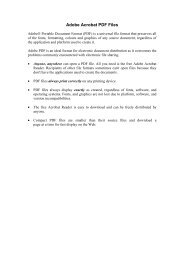You also want an ePaper? Increase the reach of your titles
YUMPU automatically turns print PDFs into web optimized ePapers that Google loves.
272<br />
Notes to pages 56–64<br />
6. “As the entertainment and information markets have gotten more complicated, the<br />
copyright law has gotten longer, more specific, and harder to understand. Neither book<br />
publishers nor libraries have any interest in making the library privilege broad enough<br />
so that it would be useful to users that aren’t libraries, and neither movie studios nor<br />
broadcast stations have any interest in making the broadcaster’s privilege broad enough<br />
to be of some use to say, cable television or satellite TV, so that doesn’t happen. Negotiated<br />
privileges tend to be very specific, and tend to pose substantial entry barriers to<br />
outsiders who can’t be at the negotiating table because their industries haven’t been invented<br />
yet. So negotiated copyright statutes have tended, throughout the century, to be<br />
kind to the entrenched status quo and hostile to upstart new industries.” Litman, Digital<br />
Copyright, 25.<br />
7. Communications Decency Act of 1996 (47 U.S.C. §§ 230, 560, 561) (1996).<br />
8. Reno v. ACLU, 521 U.S. 844 (1997).<br />
9. James Boyle, “Overregulating the Internet,” Washington Times (November 14, 1995),<br />
A17.<br />
10. See James Boyle, “The One Thing Government Officials Can’t Do Is Threaten Their<br />
Critics,” Washington Times (March 6, 1996), A16.<br />
11. “The DFC was forged in 1995 in response to the release of the Clinton administration’s<br />
White Paper on Intellectual Property and the National Information Infrastructure. The<br />
White Paper recommended significantly altering existing copyright law to increase the<br />
security of ownership rights for creators of motion pictures, publishers and others in<br />
the proprietary community. Members of the DFC recognized that if the policy proposals<br />
delineated in the White Paper were implemented, educators, businesses, libraries,<br />
consumers and others would be severely restricted in their efforts to take advantage of<br />
the benefits of digital networks.” See http://www.dfc.org/dfc1/Learning_Center/about.<br />
html.<br />
12. See the classic account in Mancur Olson, The Logic of Collective Action: Public Goods<br />
and the Theory of Groups, 2nd ed. (Cambridge, Mass.: Harvard University Press, 1971).<br />
13. See note 2 above.<br />
14. Pub. L. No. 105-147, 111 Stat. 2678 (1997) (codified as amended in scattered sections of<br />
17 and 18 U.S.C.).<br />
15. Pub. L. No. 105-298, 112 Stat. 2827 (1998) (codified as amended in scattered sections of<br />
17 U.S.C.).<br />
16. S 2291, 105th Cong. (1998).<br />
17. Sony Corp. of America v. Universal City Studios, Inc., 464 U.S. 417 (1984).<br />
18. See Tina Balio, Museum of Broadcast Communications, “Betamax Case,” Encyclopedia<br />
of TV (1997), available at http://www.museum.tv/archives/etv/B/htmlB/betamaxcase/<br />
betamaxcase.htm (“The Betamax case went all the way to the Supreme Court, which<br />
reversed the appeals court decision on 17 January 1984. By 1986, VCRs had been installed<br />
in fifty percent of American homes and annual videocassettes sales surpassed the<br />
theatrical box-office.”). The year 1986 was also the peak of the video rental market:<br />
“Video’s high mark, according to studies by A. C. Nielsen Media Research, was in late<br />
1986, when an estimated 34.3 million households with VCR’s took home 111.9 million<br />
cassettes a month, or an average of 3.26 movies per household.” Peter M. Nichols,










